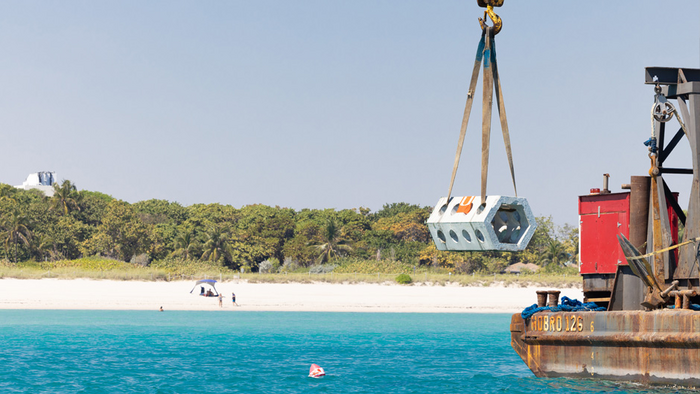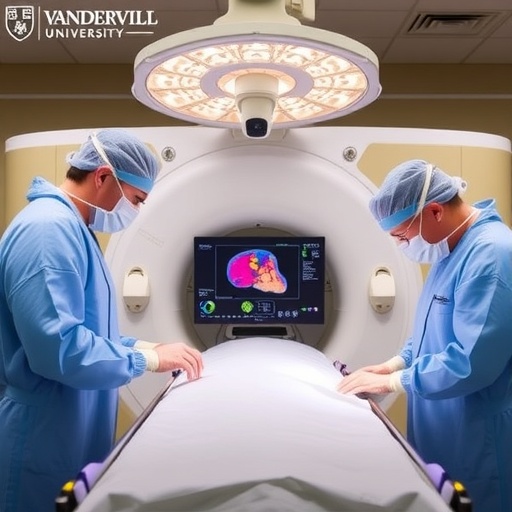The first piece of a series of concrete structures was lowered into the water off the coast of Miami Beach on Wednesday morning, a massive crane on the deck of a floating barge hoisting the unit into the air and sinking it to the seabed.

Credit: Photos: Joshua Prezant/University of Miami
The first piece of a series of concrete structures was lowered into the water off the coast of Miami Beach on Wednesday morning, a massive crane on the deck of a floating barge hoisting the unit into the air and sinking it to the seabed.
During the next six hours, crewmembers aboard the barge would repeat that process until the structures, some stacked on top of each other, were settled on the seafloor, 14 feet below the surface.
To casual observers onshore, the daylong operation might have seemed routine. But this maritime activity was hardly run-of-the-mill.
In a project that could pave the way for greater efforts to protect coastlines from sea level rise and storm surge and serve as an innovative base structure to develop thriving coral reefs, a team of researchers and scientists from the University of Miami sunk 27 interlocking concrete structures that will form two hybrid reef units 1,000 feet offshore of North Beach Oceanside Park, at the northern edge of Miami Beach.
The units are the centerpiece of a project called Engineering Coastal Resilience Through Hybrid Reef Restoration, or ECoREEF, which combines cement- and nature-based strategies to foster coastal resilience. Supported by the University’s Laboratory for Integrative Knowledge (U-LINK) and the City of Miami Beach, the project was developed at a time when coral reefs are struggling to survive. A recent study indicates that half of the world’s living coral reefs have died since the 1950s. Meanwhile, other research has shown that healthy and complex coral reefs are able to buffer up to 97 percent of the energy from waves and can also reduce flooding frequency.
“Coral reefs are disappearing at alarming rates throughout the world as a result of disease and warming oceans, so our reefs have lost a lot of the structure they need to reduce wave energy,” said ECoREEF lead investigator, Diego Lirman, an associate professor of marine biology and ecology at the University’s Rosenstiel School of Marine, Atmospheric, and Earth Science. “By placing these [hybrid] reefs near the shoreline and planting stress-tolerant corals on them, we hope to recover some of the lost services provided by healthy reefs, such as coastal protection, and to build a habitat for organisms like fish and lobsters.”
One of the hollow structures submerged this week was shaped like a trapezoid, with rocks on its outer surface to mimic the texture of coral reefs and to attract marine life. The other unit is a series of hexagons, the iconic honeycomb-like shape that is being incorporated into more and more projects, including the powerful Webb Telescope. Perforated to allow seawater to flow through them, the hollow, hexagonal SEAHIVE structures—tubes that look like honeycomb and each weighing 2,500 pounds—are stacked in a pyramid-like shape and attached to a few solid concrete SEAHIVEs to enhance the stability of the structure.
To build the hybrid structures, researchers also used an eco-friendly concrete mixture, with composite reinforcements instead of steel, both for durability and to attract marine life.
Haus and Rhode-Barbarigos peer through a six-foot-tall perforated SEAHIVE unit, which they designed with other faculty members, on the barge that lowered dozens of the units into the ocean.
“Designing structures to dissipate wave energy while providing a hospitable environment for corals has been a challenge,” said Landolf Rhode-Barbarigos, an assistant professor in the College of Engineering, and one of the project’s lead investigators. “There are no design guidelines for nature, but hopefully this can be translated into something bigger and provide novel solutions for coastal protection.”
It was Rhode-Barbarigos, along with Lirman, marine biologist Andrew Baker, ocean scientist Brian Haus, sustainable architect Sonia Chao, and communications expert Jyotika Ramaprasad, who joined forces in 2018 to address challenges of coastal resilience. They hope the ECoREEF project will lead to a better understanding of the types of structures that can help protect South Florida’s vulnerable coastline from erosion and storm surge.
“We want to see how these two different alternatives for a hybrid, engineered structure and a natural reef compare,” Haus said. “This is a research installation, so we’ll be examining it in a variety of ways.”
Corals grown at the Rosenstiel School’s three nurseries will eventually be attached to the hybrid reefs, allowing them to thrive and replace some of the area’s many coral reefs lost to disease and bleaching that is the result of warming ocean temperatures.
“We are hoping that we can get baby corals to attach and get a community that looks similar to a natural reef developing on these structures over time,” Lirman said.
But for now, the reefs must get acclimated to their new underwater environment.
Divers and drones will help monitor the structures; and soon, researchers will install current meters and wave sensors from the U.S. Geological Survey to measure wave energy and flow on the surface of the reefs, according to Brian Haus, professor and chair of ocean sciences at the Rosenstiel School.
After two previous attempts to deploy the structures were called off because of inclement weather, ideal conditions—calm waters and little to no wind—made it possible for crews to sink the structures.
Onboard the barge which carried the hybrid reefs—after a tugboat had brought them more than 100-nautical-miles from Fort Pierce to Miami Beach—Haus and Rhode-Barbarigos helped orchestrate the deployment, directing the crane that lowered the structures into the water and making sure the reefs were positioned and stacked correctly on the seabed. A diver who patrolled the seafloor ensured the structures aligned properly.
“We got our hands a little bit dirty today, but it was worth it,” said Haus, who oversees the Rosenstiel School’s 75-foot-long, 38,000-gallon Alfred C. Glassell, Jr. SUSTAIN Laboratory wind-wave tank, which researchers used to test small-scale versions of the hybrid reefs.
Should a tropical cyclone threaten or even strike South Florida this coming hurricane season, the hybrid reefs could get their first big test, which is why the team went through a meticulous permitting process, Rhode-Barbarigos said.
A grant from U-LINK helped jump-start the project, and the group soon partnered with the City of Miami Beach. The U-LINK initiative was founded in 2018 to offer interdisciplinary faculty teams seed funding to devise novel solutions to pressing societal issues. Since then, 40 other teams have been formed, and many of them have garnered additional external funding. Last summer, Baker, Lirman, Rhode-Barbarigos and Haus, among others, received a massive grant from the Defense Advanced Research Projects Agency (DARPA), a division of the U.S. Department of Defense, to scale up their designs and help protect military and civilian infrastructure along the coast.
“This EcoReefs project will give us a test bed for this technology, before we do a deployment of a much larger structure for the DARPA grant elsewhere in Florida,” Lirman pointed out.
While the U-LINK project was evolving, Rhode-Barbarigos was also working with Haus and College of Engineering faculty members Antonio Nanni, Esber Andiroglu, and Prannoy Suraneni to develop the SEAHIVE structure through grants from the National Comparative Highway Research Program and the Florida Department of Transportation. Initially created as an alternative to traditional seawalls because of their ability to mitigate wave energy, the honeycomb-shaped SEAHIVE units are also set to be tested at two other South Florida locations.
Miami Beach officials are eager to see how both hybrid reefs perform in the waters off North Beach Oceanside Park.
“The launch of this experimental [hybrid] reef marks a pivotal moment in our efforts to protect Miami Beach from coastal erosion and restore our coral ecosystem,” said Ricky Arriola, a Miami Beach commissioner. “Not only will this innovative solution help safeguard our shores, but it will also drive ecotourism and further establish Miami Beach as a leader in sustainable coastal management.”
Amy Knowles, the city’s chief resilience officer, agreed. “We can’t wait to see how this hybrid reef grows,” she said. “Coral reefs are an important part of marine life, and our coastal resilience to storm surge and sea level rise for Miami Beach and our broader region.”
For the faculty members who worked on the project since its inception four years ago, this deployment marked an achievement.
“It’s been a long adventure, so we’re understandably excited,” Rhode-Barbarigos said. “It’s a milestone moment because we’ll be able to learn from these units both from an engineering and ecological perspective. What we accomplished today is the end of one phase, but the beginning of another.”





